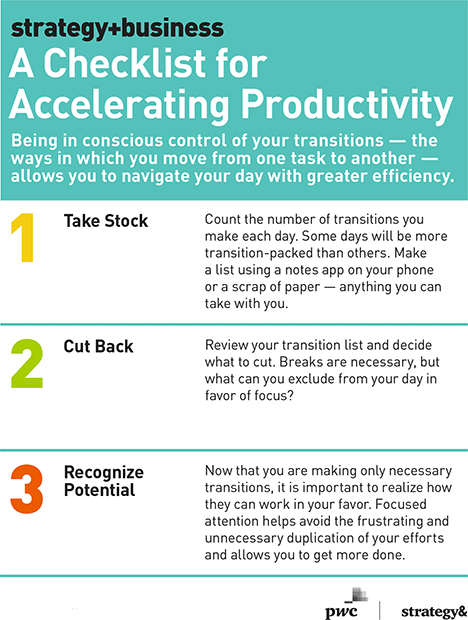The Art of the Transition
How to navigate from task to task with greater efficiency.
Transitions, the flexible moments between changes, simultaneously shape the clarity of an ending and the quality of the next beginning. And although the “big” transitions at work naturally capture our focus and attention (e.g., leaving one organization to start a new job at another), we engage in numerous microtransitions every day. Examples include switching from answering emails to writing a report; wrapping up a face-to-face meeting and then dialing into a conference call; and getting up to grab coffee, only to find yourself having an unplanned hallway conversation with a colleague.
Collectively, these small, malleable moments have the potential to accelerate our productivity or bog it down with inefficiencies, distractions, and false starts. Being in conscious control of your transitions allows you to navigate your day with greater efficiency.
Here are some strategies to help you master the art of the transition.
Take stock. You can’t do anything about a challenge you can’t see. To more effectively manage your transitions, first take an inventory of them. Of course, no two days are exactly alike, but even a ballpark estimate of how many transitions you move through in a given day will help you see what’s at stake if you mishandle and undervalue them.
To more effectively manage your transitions, first take an inventory of them.
This exercise is about developing more awareness around the scope and impact of each transition. It can be an eye-opening experience, as it was for one of my clients, a senior leader who desperately wanted to get a handle on her unmanageable workload. “I’m working on four different projects across three time zones, so I knew I was busy. Still, there were more transitions than I imagined,” she told me. After taking stock, she found that a typical day had anywhere from 75 to 100 discrete transitions.
She continued: “My head is always on a swivel. I pivot from planning and reflecting to executing a variety of tasks. And because I’m working with different teams, I have to approach things differently based on diverse expectations. Some people want an email, while others want to hear my voice. Some people want minimal details, while others want a complete rundown. From emails, to phone calls, to slide decks, to meetings — the day is in constant motion. And because all of my stakeholders think their projects are the top priority, I’m forced to continuously shift among them to keep everyone happy.”
Most illuminating for this leader was the connection between the volume of daily transitions and the quality of her work on the days when her transitions were rough — when every transition felt like a firefighting exercise, the results of her efforts were inconsistent and suboptimal. Each haphazard shift from one task to another often created collateral damage — errors, false starts, etc. — that made those days feel longer and much less productive.
Take a few moments right now to consider the scope and nature of the transitions you make to address your daily responsibilities. Look at your calendar to take stock of the categories (including scheduled calls, meetings, and working sessions) and consider the white space on your calendar where unbudgeted time is invested in unexpected asks, impromptu tasks, and unnecessary distractions. After a first pass, dig even deeper to assess the before and after phases of the items on your list to spot all of the microtransitions you make.
Cut back. Although there are some external circumstances that dictate the volume and pace of your transitions, you have more control over them than you may realize. Every transition requires some investment of attention and focus, so think of them as a cost — or recurring expenditure — that should be wisely budgeted.
For example, a lapse in your attention that results in a 10-minute plunge into your phone is not a reason to transition; it’s just an unnecessary switch that you made. However, despite the seemingly innocuous nature of it, you still must pay the price in your efficiency and productivity. Research behind the fallacies of multitasking are instructive here. Or, more to the point, the liabilities of multitasking are worth reviewing.
But it goes beyond that. Transitions are about both efficiency and effectiveness. As the late management thinker Peter Drucker is famous for saying: “Efficiency is doing things right; effectiveness is doing the right things.” To make sure your transitions are both efficient and effective, reduce the unnecessary ones and then get the timing right for the ones you need.
Recognize potential. Once you have a better handle on your transitions, you can begin to not only notice their pitfalls, but the opportunities they present in the ways that they help you navigate your obligations.
Take this transition, for example: After finishing a 30-minute email sprint to clear your inbox, you quickly grab your bag and head out to a face-to-face meeting. Now imagine that your last email was hastily written in a rush to get out the door. This breakdown could signal a disordered and inefficient transition; indeed, after the meeting starts, you realize that a key point was poorly communicated in the email or left out altogether. Or maybe somebody was supposed to be copied, but he or she was inadvertently left off the thread. This thought has already stolen your focus from the meeting. And if you have to pull out your phone to resend the email, it will distract you from the present moment while taking more unbudgeted time to make the situation right.
The excuses we make for sloppy transitions are often misleading. “Sorry, I had to check out of the meeting for a few minutes; there was an urgent email I needed to send!” A more candid and accurate description is: “Sorry, I rushed the transition between my email sprint and this meeting, which resulted in a mistake. So I had to correct my oversight and repeat the transition all over again! What did I miss?”
Microtransitions often go unnoticed, but if you give them focused attention and manage them well, you’ll avoid the frustrating and unnecessary duplication of your efforts while getting more of the right things done. However, if the potential of your transitions to keep you efficient and effective is squandered throughout the day, the cumulative drain on your productivity is palpable.
Even if you have administrative support or a subscription to the greatest efficiency app on the market, you can’t outsource your transitions. But strategies such as these can turn you into a student of your own behavior and help you discover what the data of your daily experience can teach you. With this increased self-awareness, you can practice the art of the transition in a way that reveals important truths about your mental focus, perspective on priorities, and engagement levels throughout the day. By taking stock, cutting back, and recognizing the potential of your transitions, you can make every nuanced pivot point a successful ending of one task and a promising start to the next.





